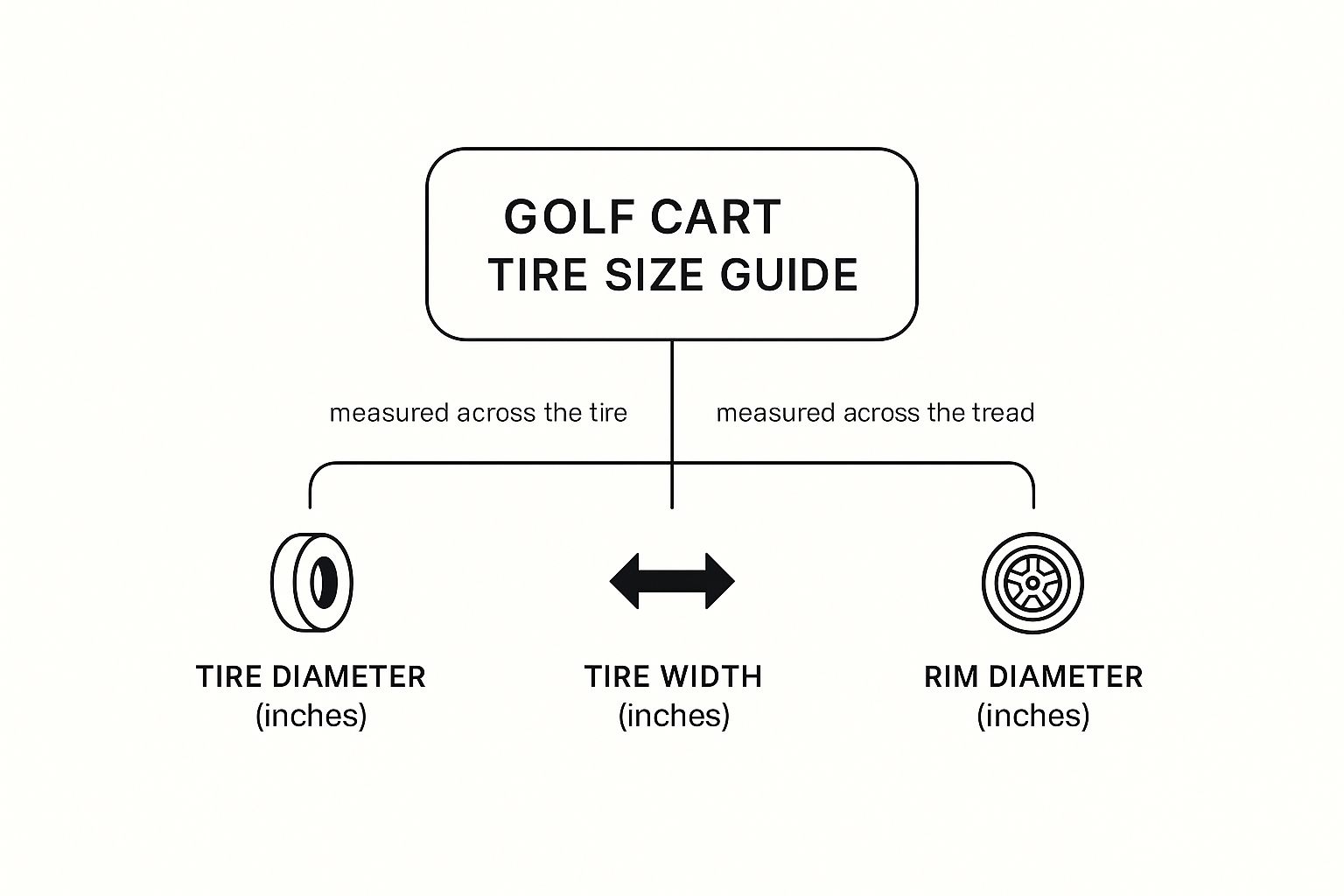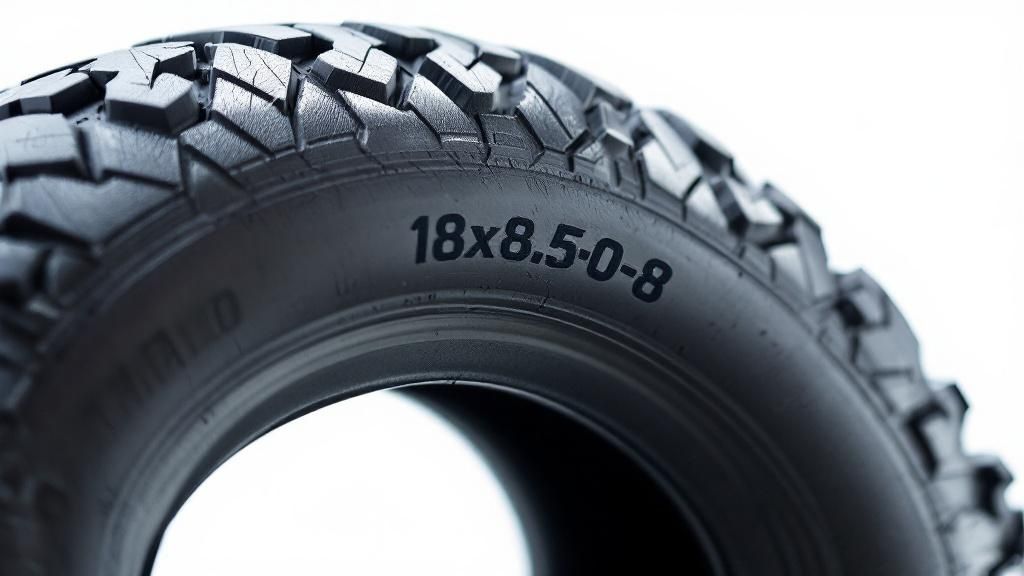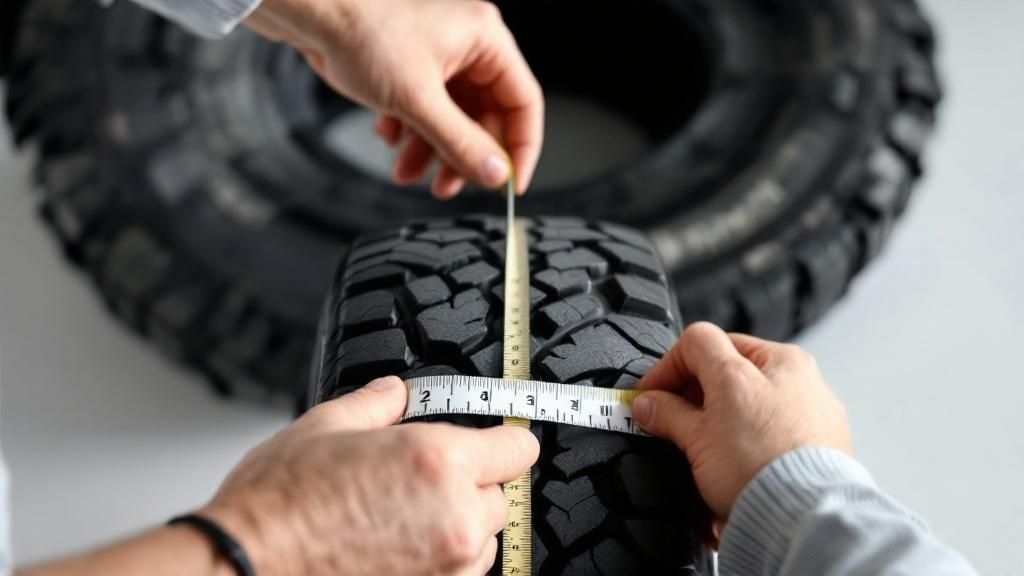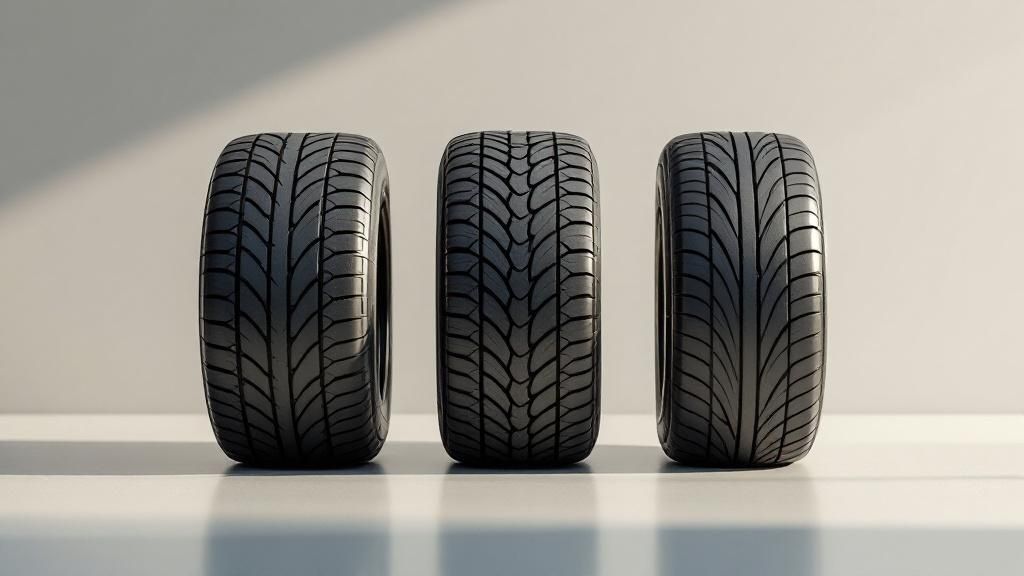Staring at a tire sidewall full of numbers like 18×8.50-8 can feel a bit like you're trying to crack a secret code. But don't worry, it's actually much simpler than it looks. Think of it as a basic "size tag" for your golf cart's shoes.
Understanding this three-part code is the single most important step in finding the right tires. It's the foundation for everything else.
How to Read Golf Cart Tire Sizes Instantly
That sequence of numbers stamped on your tire's sidewall is the most critical piece of information you have. It's not just some random model number; it's a precise blueprint that tells you if a tire will even fit your cart, how it's likely to perform, and what kind of ride to expect.
Let's break down the most common format you'll see, using 18×8.50-8 as our guide. Each number has a very specific and straightforward job.
Decoding the Three-Number System
The standard sizing system is your key to understanding what you have now and what you can get next. It's really no different than reading the dimensions on a shipping box—it’s just Height x Width x the size of the thing it fits on.
To make it crystal clear, here’s a quick breakdown of what each number in our 18×8.50-8 example means.
Quick Guide to Standard Tire Codes (Example 18×8.50-8)
| Number Position | What It Represents | Example (18×8.50-8) | Why It Matters |
|---|---|---|---|
| First | Overall Tire Height | The tire is 18 inches tall. | This determines your ground clearance and is the main factor in whether you'll need a lift kit for your golf cart. |
| Second | Overall Tire Width | The tire is 8.50 inches wide. | A wider tire can offer more stability and traction, but too wide and it might rub against the frame during sharp turns. |
| Third | Wheel (Rim) Diameter | It fits an 8-inch wheel. | This is non-negotiable. The tire must match the wheel size to be mounted safely. |
Mastering this simple "Height x Width – Rim" formula is the most fundamental part of choosing new tires. It lets you instantly assess any tire and understand its basic fit and function without any guesswork.
This simple diagram helps visualize how these three core measurements—tire diameter, tire width, and rim diameter—all come together.

As you can see, those three numbers are basically the tire's DNA. Each one defines a crucial physical dimension that you need to know.
Putting It All Together
So, the next time you see 18×8.50-8 on a tire, you'll know exactly what it means: an 18-inch tall, 8.5-inch wide tire made to fit on an 8-inch rim.
This specific size is incredibly common and comes standard on most non-lifted golf carts right from the factory, including major brands like Club Car, E-Z-GO, and Yamaha. It’s a great all-around size that provides a balanced, comfortable ride perfect for the golf course or paved neighborhood paths.
By getting a handle on this system, you've already overcome the most confusing hurdle for many golf cart owners. You can now walk out to your cart, confidently read the numbers on your current tires, and have a solid baseline for what you need—or what you might want to change.
Understanding Advanced Tire Markings

So you've got the basic three-number size code down. That's a great start, but the story doesn't end there. The sidewall of a tire is packed with other crucial markings that reveal its true character and capabilities. Think of it as moving from basic conversation to becoming fluent in "tire-speak."
This extra information is what separates a good choice from a great one, especially if you plan to modify your cart or push it beyond a simple round of golf. These codes tell you about the tire's strength, durability, and what it was designed for. Ignoring them can lead to poor performance, excessive wear, or even safety problems down the line.
Decoding Ply Rating and Load Range
Beyond just fitting the wheel, the most important marking you'll find is the ply rating, also known as the load range. This tells you exactly how strong the tire is and how much weight it can safely carry. It's essentially the tire's backbone—a higher rating means a tougher, more robust tire.
Now, this rating isn't about the literal number of material layers anymore. It's an industry-standard way to talk about load capacity. You'll usually see it written in one of two ways:
- Ply Rating: Shown as "B/4 Ply," "C/6 Ply," and so on. The higher the letter and number, the stronger the tire.
- Load Range: A simple letter system (A, B, C, D) that directly corresponds to the ply rating.
For instance, a "Load Range B" tire is the same as a 4-ply rating. This is the standard for most factory golf carts. But what if you've added a rear seat kit, a utility bed, or you regularly haul heavy gear? That's when you should step up to a "Load Range C" (6-ply) tire to safely manage the extra weight.
Key Takeaway: A tire's ply rating is a direct measure of its strength. If you choose a tire with a load range that's too low for your cart's total weight (passengers and cargo included!), you risk dangerous sidewall flexing, sloppy handling, and a much higher chance of a blowout.
Other Sizing Formats You Might See
While the three-number system is by far the most common, you might stumble upon other formats, especially on older or more specialized tires. One you may see is the two-number system, which looks something like 20.5×8.0-10. It’s pretty similar to the standard system, but it combines the height and width.
Here’s the simple breakdown:
- 20.5: The tire is about 20.5 inches tall.
- 8.0: The tire is 8.0 inches wide.
- 10: It’s made for a 10-inch wheel.
See? It's straightforward once you know what you're looking at. These different systems exist because the industry serves a huge variety of vehicles, from fairway mowers to heavy-duty utility carts. In fact, the global market for these turf and golf cart tires was valued at around USD 0.53 billion in 2023 and is expected to hit USD 1.5 billion by 2032, showing just how much demand there is for specialized tires. You can read more about this market growth and what’s driving it.
Getting familiar with these different codes means you’ll never be caught off guard, giving you the confidence to pick the perfect replacement every single time. This complete understanding of the golf cart tire size guide is your key to keeping your vehicle in top-notch shape.
How to Measure Tires When the Numbers Are Gone

Time and the elements can be pretty harsh on rubber. Over the years, those essential numbers on a tire's sidewall can crack, fade, or get scraped clean off, leaving you with a real headache when it's time for a replacement. But what do you do without those crucial size markings? Just take a wild guess?
Absolutely not. All you really need is a tape measure and a few minutes of your time.
This is a skill every cart owner should have, especially if you're working on an older model, restoring a barn find, or just dealing with some well-loved tires that have seen better days. Getting these measurements right is how you create your very own golf cart tire size guide when the original one is long gone.
Step 1: Measure the Overall Tire Height
First thing's first: let's get the tire's total height, also known as its overall diameter. This measurement corresponds to the first number in a standard size code (like the "18" in 18×8.50-8). It's probably the most critical dimension, as it dictates your cart's ground clearance and tells you if you’ll need a lift kit.
To get this right, you have to measure the entire inflated tire from the ground to the very top of the tread—not just the wheel.
- Lay a straight edge, like a level or a small piece of wood, across the top of the tire tread.
- Make sure that straight edge is sitting perfectly level with the ground.
- Now, use your tape measure to find the distance from the ground up to the bottom of that straight edge.
- Round what you get to the nearest half-inch. So, if your tape reads 18.25 inches, you've got an 18-inch tire.
This number is your tire height. Getting this measurement correct is what stops you from buying a tire that’s too tall and rubs against the fender well on every single turn.
Step 2: Determine the Tire Section Width
Next up is the tire's width. This is the second number you see in the size code (the "8.50" in 18×8.50-8), and it tells you how much rubber actually meets the road. This directly impacts your cart's stability and traction.
For an accurate reading, you need to measure the tire at its absolute widest point, from one sidewall to the other. Don't just measure the tread surface, because the sidewalls almost always bulge out a bit further.
- Hold your tape measure horizontally across the tire.
- Find the widest part of the tire, which is usually right in the middle of the sidewall.
- Measure from the outermost point of one sidewall straight across to the outermost point of the other.
This measurement is your section width. If it comes out to 8.6 inches, you can round that down to 8.50 for your size code.
Pro Tip: For the most accurate height and width, make sure the tire is inflated to its recommended PSI. An under-inflated tire will sag, throwing off your height measurement and giving you a wider, distorted width reading.
Step 3: Identify the Wheel and Bolt Pattern Size
Last but not least, you need the wheel diameter—often called the rim diameter. This is the final number in the size code (the "8" in 18×8.50-8), and it’s a non-negotiable measurement. A tire will only fit safely on a wheel of the correct size.
To find this, you're measuring the metal wheel itself, ignoring the rubber tire. Measure from the edge of the wheel bead (where the tire actually sits) straight across to the opposite edge. You'll almost certainly find it's a nice round number like 8, 10, 12, or 14 inches.
While you're down there, it's a smart move to check your wheel’s bolt pattern. This guarantees that any new wheel-and-tire combo you're eyeing will actually bolt onto your cart's hub. For a standard 4-lug golf cart wheel, just measure from the center of one bolt directly across to the center of the opposing bolt. The most common pattern you'll find is 4×4 inches (sometimes listed as 4×101.6mm).
Matching Tire Sizes to Your Driving Style
Now that you know how to read and measure tire sizes, we can get to the fun part: connecting those numbers to how your cart actually performs on the ground. Think of it like picking the right shoes for the job. You wouldn't wear flip-flops on a rugged hike, and you wouldn't wear steel-toed boots to the beach. The same idea applies perfectly to your golf cart.
A tire's size does more than just determine if it fits on the wheel. It’s the single biggest factor in how your cart handles, where it can go, and how smooth the ride feels. Picking the right size turns your cart into the perfect tool for whatever you have in mind, whether that’s gliding silently across a fairway or confidently exploring a backcountry trail.
Standard Sizes for Paved Paths and Turf
For most cart owners, the mission is simple: a smooth, stable ride on predictable surfaces like golf courses, neighborhood streets, and paved community paths. This is where standard, non-lifted tire sizes are the undisputed champions. The most common size you'll see is 18 inches tall, usually written as 18×8.50-8.
This size is the industry standard for a reason. It delivers a fantastic balance of comfort, efficiency, and nimble handling without needing a single modification to your cart's suspension.
- 18-inch Tires: The go-to choice for turf and pavement. Their low center of gravity keeps the cart incredibly stable, and their gentle footprint won't tear up delicate grass.
- Ideal Use Cases: Cruising the fairways, navigating a resort, or running errands on smooth local roads.
These tires are engineered for a quiet, efficient ride. They also place less demand on the motor, which is an important thing to think about when deciding between an electric or gas golf cart, as tire size directly impacts your range or fuel economy.
The market numbers tell the story. The 18×8.50-8 tire, which hits the sweet spot between cost and performance, accounts for about 6 million units made every year. The slightly narrower 18×8.0-8 tire, common on smaller carts, isn't far behind with around 4 million units produced annually.
All-Terrain Sizes for Mixed Use
But what if your adventures don’t stop where the pavement ends? If you regularly find yourself on gravel roads, packed dirt trails, or just cruising around your own property, you’ll need a tire with more bite and durability. This is where mid-size all-terrain tires, typically 20 to 22 inches tall, really come into their own.
A 20-inch tire is usually the biggest you can fit on a standard, non-lifted golf cart without running into clearance problems. It gives you a welcome boost in ground clearance for rolling over small obstacles and adds a more aggressive, capable look.
A 20-inch all-terrain tire is the perfect middle ground. It gives you more capability for light trail use and a tougher appearance, often without the cost and hassle of installing a lift kit.
Once you jump to a 22-inch tire, however, you are officially in lift kit territory. These taller tires provide serious ground clearance and a much more commanding stance, making them ideal for handling more demanding terrain. They beautifully bridge the gap between casual neighborhood cruising and serious trail riding.
Large Sizes for Off-Road Dominance
For those who see their golf cart as a true utility vehicle or trail machine, only the biggest, baddest tires will do. Tires that are 23 inches or taller are built for one thing: off-road performance. They feature deep, chunky treads designed to claw through mud, dig into sand, and crawl over rocks.
These are absolutely not your golf course-friendly tires. In fact, their aggressive tread would chew up a manicured fairway in seconds. They are purpose-built for maximum traction and toughness in the wild.
- 23-inch+ Tires: Strictly for off-road and serious trail use.
- Lift Kit: A 5-inch or 6-inch lift kit is mandatory for proper clearance.
- Key Benefit: Unmatched ground clearance and traction to conquer the most challenging environments.
Choosing a tire this large is a full commitment to off-road adventure, and it will completely change what your cart is capable of. Just remember, pairing them with a quality lift kit is non-negotiable to avoid dangerous tire rub that can damage your cart's body and steering.
To make it even clearer, here's a quick breakdown of the most common tire sizes and where they excel.
Common Golf Cart Tire Sizes and Their Best Use Cases
| Tire Size | Primary Use | Lift Kit Required? | Key Benefit |
|---|---|---|---|
| 18" | Pavement & Golf Courses | No | Smooth ride, turf-safe, maximum stability |
| 20" | Pavement & Light Trails | No (on most carts) | Added clearance with a tougher look |
| 22" | Mixed-Terrain & Trails | Yes (3"-4" lift) | Significant ground clearance, great all-arounder |
| 23"+ | Aggressive Off-Roading | Yes (5"-6" lift) | Maximum traction and obstacle clearance |
Ultimately, picking the right size comes down to being honest about how you'll use your cart most of the time. This table should help you narrow down the perfect option for your needs.
When You Need a Lift Kit for Larger Tires

There's no faster way to give your golf cart a total personality overhaul than by slapping on a set of big, aggressive tires. It instantly transforms a tame neighborhood vehicle into something that looks like it's ready to conquer a trail. But getting that commanding look and off-road capability takes more than just swapping out the rubber.
So, before you click "buy" on those massive new tires, you need to read this. Once you start looking at tires taller than 20 inches, a lift kit stops being an optional accessory and becomes an absolute necessity. It’s the key piece of the puzzle that makes the whole upgrade work safely and correctly.
Why a Lift Kit Is Absolutely Necessary
A lift kit does exactly what it sounds like: it raises the body of your golf cart higher off the ground. This creates the critical space needed inside the wheel wells for those taller tires to fit without smashing into the cart’s body every time you hit a bump or make a sharp turn.
Think about it this way: trying to mount a 23-inch tire on a stock, unlifted cart is like trying to cram your size 12 foot into a size 9 shoe. It’s just not going to work. The lift kit is the bigger shoe—it creates the room you need for a proper fit.
Without that extra space, you’re asking for a major headache called tire rub. This is when your tire scrapes against the fender, frame, or suspension parts. In a best-case scenario, it’s just an awful noise. Worst case? It can chew through the sidewall of your brand-new tire and cause a dangerous blowout.
Matching Lift Height to Tire Size
Thankfully, there’s a straightforward relationship between tire height and the size of the lift kit you’ll need. The taller the tire, the more lift you need. Nailing this combination is the secret to a successful upgrade, ensuring you have plenty of clearance for your suspension to do its job.
While it can vary slightly, here’s a solid rule of thumb that applies to most Club Car, E-Z-GO, and Yamaha carts:
- 20-Inch Tires: You can sometimes get away with these on a stock cart, but a 3" lift is a smart move for extra peace of mind.
- 22-Inch Tires: You'll definitely need at least a 3-inch to 4-inch lift kit to avoid rubbing issues.
- 23-Inch Tires: These require a 5-inch or 6-inch lift kit. This is non-negotiable for safe operation.
Critical Insight: Don't ever try to cheap out and use a smaller lift than what's recommended for your tire size. Forcing it not only risks shredding your tires but also puts incredible strain on your steering and suspension components, which can cause permanent damage and create a seriously unsafe ride.
Understanding Different Lift Kit Types
Not all lift kits are built the same. They typically fall into two main categories, and the best one for you will depend on your cart model, your budget, and how comfortable you are with turning a wrench.
-
Drop Spindle Lift Kits: These are probably the most popular choice because they're relatively easy to install. They work by replacing your stock spindles with longer ones, which lowers the wheel hub and lifts the cart. The big advantage is that they preserve your factory ride quality.
-
Drop Axle Lift Kits: This style involves swapping out the entire front axle with a beefier one that has a drop built right in. They are known for being incredibly tough and durable, which makes them the go-to choice for serious off-roading. For a look at carts built for this kind of action, check out this guide on the best electric golf cart off-road models.
Ultimately, picking the right lift kit is just as important as choosing the right tires. It’s the foundation that provides the clearance, stability, and safety you need to truly enjoy your cart’s new capabilities.
Common Questions About Golf Cart Tires
Even after you've got a handle on tire sizes, measurements, and lift kits, a few practical questions always seem to surface. It's totally normal. Let's tackle some of the most common points of confusion to help you keep your cart in top shape, buy smarter, and get more enjoyment out of every drive.
Can I Put Larger Tires on Without a Lift Kit?
This is, without a doubt, the question we hear most often. The answer is critical for the health and safety of your golf cart.
For the majority of standard, non-lifted carts from big names like Club Car, E-Z-GO, and Yamaha, the absolute largest tire you can fit is 20 inches tall. Since most stock tires are 18 inches, this gives you a little wiggle room to get a beefier look without major modifications.
But be careful. If you try to push past that 20-inch limit, you're almost guaranteed to get tire rub. That’s when your tire scrapes against the frame or wheel well, especially when you turn or hit a bump. It’s more than just an annoying noise—it can shred your tires and become a serious safety issue. For any tire that is 21 inches or taller, a lift kit isn't just a suggestion; it's a must-have for safe operation.
What Is the Right Tire Pressure for My Cart?
Figuring out the right tire pressure (PSI) is actually pretty simple. The answer is always molded right into the tire’s sidewall. Look for text like "Max PSI" or "Inflate to X PSI" and follow that number exactly. There's no need to guess.
Most golf cart tires run in the 15 to 25 PSI range. Keeping them properly inflated is one of the easiest ways to ensure great performance and long life.
- Under-inflated tires will give you sloppy handling, drain your battery faster, and wear out the outer edges of the tread.
- Over-inflated tires create a rough, bouncy ride and cause the center of the tread to wear down way too quickly.
Should I Replace All Four Tires at Once?
Yes, absolutely. We always recommend replacing all four tires at the same time. This keeps every tire at the same height, with the same tread depth and circumference. That consistency is what gives you a stable, predictable ride.
When you have mismatched tires, your cart can start pulling to one side, feel unstable, and put extra strain on the suspension and drivetrain. While keeping your power source in good shape is vital, proper golf cart battery maintenance can't fix the problems that unbalanced tires create.
If buying a full set of four just isn't in the budget right now, the next best thing is to replace them in pairs. Do both front tires or both rear tires together. This maintains balance on each axle and is a much safer option than just swapping out a single tire.
At Solana EV, we believe a great ride starts from the ground up. Whether you're cruising your neighborhood or hitting the trails, having the right tires is a game-changer for performance, safety, and style. Our premium, street-legal electric vehicles are built for an incredible experience, and we're here to help you make every journey a great one.
Explore the Solana EV lineup and find your perfect ride today.
